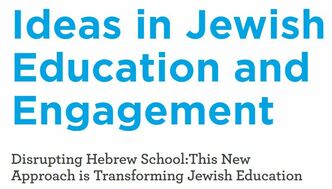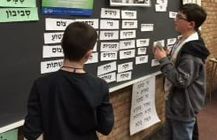 #OnwardHebrew is disrupting not only Hebrew learning in part-time/congregational settings, but beginning to have major impact on Jewish learning, as well. Check out this blog post from the Jewish Federations of North Americal webpage by Nachama Skolnik Moskowitz
0 Comments
 In early January 2019, results from the recent #OnwardHebrew survey were published (click here for the full report and click here for the executive summary). The "enthusiastic-for-#OnwardHebrew" written comments were numerous, including these:
Not surprisingly, the survey results showed that the most difficult #OnwardHebrew element is changing the timing that Hebrew decoding is taught, i.e., first building an aural/oral foundation before introducing the reading/decoding process. One respondent noted, "“[Our stakeholders] are supportive of HTM, Hebrew vocabulary and Hebrew in Tefillah, but not of delaying decoding.” The education directors and clergy who first brought #OnwardHebrew to life explain that key to successful adoption and implementation are slow and careful study/deliberations with stakeholders (clergy, teachers, committee/board members, parents, etc.) AND attention to the change process. Once others understand the theory and research behind #OnwardHebrew, the early innovators suggest that their colleagues:
I would add that the rest of us would be enriched by YOUR success stories, as well as your challenges. We will be able to build upon your experiences. #OnwardHebrew! Join the conversation...
 Recently, I’ve been thinking about Gutenberg’s printing press and its harsh impact on Hebrew School. And indeed, initial drafts of this blog post began as a tirade against Gutenberg, blaming him for the struggles of many a child in Hebrew School. For if he hadn’t invented the ability to print prayerbooks in mass quantities, then worshipers wouldn’t have books in their hands, and Jewish children would not have to struggle with learning to decode Hebrew over four to six years in the learning environment known as “Hebrew School.” Yikes! It got a little complicated as I realized I couldn’t blame Gutenberg alone – the Enlightenment, Industrial Revolution and a host of other factors could also be implicated in the path to creating the current model of Hebrew learning in part-time/congregational settings. But here’s the point – two thousand years ago, Jewish prayers were shared orally, not slogged through by those learning to decode Hebrew. In the days of scribes and scrolls, an inspirational person who understood the structure of traditional worship led the community in a strong, clear voice. The people could and would do any number of things: listen, recite along with the worship leader, repeat lines or simply say amen. Prayer was an outpouring of the heart that transcended the printed page … oh, wait, there was no printed page at that time! The first written prayerbook was a letter sent by one rabbi to the community of Barcelona in the 9th century CE, and it was not until the mid-15th century that Gutenberg’s printing press made it possible to more easily duplicate copies of books. BUT, over the last few decades, we as Jewish educators have twisted ourselves into tight knots teaching our students what we assume is the one and only way to pray – book in hand, eyes following the print on the page, and using skills of decoding to stay up with the service. And how do we know (hmm, test) that students can participate comfortable in Hebrew worship? Often prior to b’nai mitzvah tutoring, someone checks their reading fluency by handing them a piece of Hebrew text that they have never seen before and asking them to read aloud. Many children struggle, some cry. Most of us learned to read as a young child because over five to six years of listening and eventually talking, we built an incredibly large vocabulary and kishke-understanding of English’s structure. A child who sounds out c-a-t often has a light bulb moment – “Oh wait, I know that word! Cat!!” But children who are asked to sound out Hebrew prayer words they don’t know and may never understand because of adult-complexity and prosaic structure (like בְּמִשְׁמְרוֹתֵיהֶם) are caught like deer in the headlights. The “I-know-that-word!”-light-bulb-moment never comes. #OnwardHebrew suggests that we go back to our roots, introducing new learners to Jewish prayer orally, without concern that they have memorized the text (oh my!) before being able to relate to the printed page. Competent and confident pray-ers are not defined by “decoding to synagogue speed with two or fewer mistakes.” In fact, it’s rather impossible to decode to synagogue speed; one HAS to have the prayers and blessings in one’s head and heart (a softer way to describe “memorize”) to stay up with the service. Besides emphasizing the singing or reciting of Hebrew prayers and blessings in t’fillah (worship), #OnwardHebrew also suggests spending years of building the sounds of Hebrew language in the hearts of our learners in other ways – Hebrew Through Movement (a fun, kinesthetic way to learn key vocabulary of holidays, prayers and blessings) and Jewish Life Vocabulary (Hebrew words that are integrated into English sentences – “What a sneeze! Labri-ut!” or “Grab your siddur, we are going to t’fillah”). Children closer to the age of bar/bat mitzvah who have richly built the sounds of Hebrew can quickly and easily learn the Alef-Bet (12-15 hours) and then match this new skill with the words and phrases now gloriously floating in their heads (oh, yes, and hearts). While I’ve moved on from blaming Gutenberg, I yearn for a return to the days of scribes, scrolls and the aural/oral learning and transmission of prayers and blessings. I challenge us as Jewish educators to release ourselves from the decades old (not millennia old) tradition of teaching in which our students often painfully decode prayers and blessings, syllable-by-syllable, word-by-word. No, I am not suggesting that we skip teaching Hebrew decoding/reading altogether. But for the sake of our young learners, I am pushing us to become more savvy about the process and more efficient with our time. If we can affect this change in our curriculum, releasing our students from years of frustrating work with pre-primers, primers, prayers and blessings, then amazingly we will have more time for engaging, meaningful and compelling Jewish learning ... which is what the Jewish educational enterprise should be about! #OnwardHebrew!! Join the conversation here (comments are welcome, below) and on Facebook! Kol tuv ("all the best") <<just a little Jewish Life Vocabulary thrown in! Nachama Skolnik Moskowitz, Director of Curriculum Resources Jewish Education Center of Cleveland We are excited to share supports for the integration of Jewish Life Vocabulary, offering you avenues for introducing your community to Hebrew words and phrases by infusing them into English sentences ("What an interesting argument! I'd say eilu v'eilu - it's both this and that!"). On our JLV webpages you'll find:
Note that documents have been offered both as PDFs (so that the formatting and Hebrew font "holds") and in Word so that you may edit the lists as desired, adding or subtracting vocabulary that better fits your community. Do you have unique ideas for integrating JLV into your educational program? Please share with the rest of us - either via the contact form on the homepage of this website OR by creating a post in the Facebook group. Questions, comments and corrections are welcome, too!  Two related articles were posted recently to the #OnwardHebrew Facebook group, both supporting the sound-to-print approach, but using examples from the non-Jewish world. Julia Unger Zorn noted that the Suzuki method of learning violin is also sound-to-print. Students hear music and play music before learning to read musical notes. The article she shared is here: https://suzukiassociation.org/about/suzuki-method/ Rabbi Stacy Rigler offered an article that encourages educators to wait for student readiness, rather than rushing the teaching of reading (and other subjects) at too early of an age. That article is here: https://www.edutopia.org/article/teach-kids-when-theyre-ready and a segment of Stacy's workshop presentation ("why delay decoding") is here: https://youtu.be/UmIFO2CAFwY Both articles offer language for us to offer parents when entering into conversations about a developmentally appropriate time to teach decoding. General comments/feedback is welcome, as well as experiences (successful or not) you've had when discussing delaying decoding with your families.  This website (and postings on Facebook) offers multiple invitations to "join the conversation." We don't want you to "jump on the bandwagon," play "follow the leader," or "go where no one has gone before." Rather, #OnwardHebrew invites you to enter into dialog about the current approach to Hebrew learning that has dominated part-time/congregational learning for decades. In some ways, each of the education directors who adopted new approaches to Hebrew education, began as anthropologists. They carefully observed their current programs - noting behaviors of students and teachers, interpreting conversations ("what did I hear and what do I think it means?"), and considering the larger social sphere in which their congregation was situated. To their credit, they did not do all this in a vacuum. Rather, they connected with each other to share observations, debate conclusions and consider potential next steps. As a result, each program is different, but because of their thoughtful interactions, new assumptions about Hebrew education began to emerge, resulting in a spark to Hebrew learning not seen in the recent past. This is the power of conversation! It's not about me alone and it's not about you alone. But my sharing and your sharing will help us all develop learners that are exited about Hebrew, and grow in their competence and confidence. #OnwardHebrew. Join the conversation ... with your staff, with local and national colleagues, on this blog, and on Facebook. Really. Let's talk! The OnwardHebrew website has been launched! Yay! But we're still finding bugs and dead-end links. Feel free to be in contact if YOU find something not working correctly.
#OnwardHebrew! Join the conversation! |
AuthorSAll of us! If you have something to contribute, send your posting via the Contact webpage! Archives
September 2023
Categories
All
|

 RSS Feed
RSS Feed